On February 24, 2022, Russia launched a military invasion of Ukraine and advanced toward the capital of Kyiv. The invasion has led for calls for humanitarian protections for Ukrainians—both in the United States and abroad—including a new Temporary Protected Status (TPS) designation.
TPS is a temporary immigration status provided to nationals of a country that is experiencing problems that make it difficult or unsafe for their nationals to be deported there. TPS has been a lifeline to hundreds of thousands of people who are in the United States when problems in their home country make their departure or deportation untenable. This fact sheet provides a demographic overview of the population of Ukrainians in the United States who may qualify for TPS, and what benefits TPS would confer upon those individuals.
What is Temporary Protected Status?
Congress created TPS as part of the Immigration Act of 1990. It is a temporary immigration status provided to nationals of specifically designated countries that are experiencing an ongoing armed conflict, environmental disaster, or other extraordinary temporary conditions. It provides a work permit and stay of deportation to foreign nationals from those countries who are in the United States at the time the U.S. government makes the designation.
Who is Eligible for TPS?
In order to qualify for TPS, an individual must:
- Be a national of the foreign country that has a TPS designation (or if stateless, have last habitually resided in a country with a TPS designation);
- Be continuously physically present in the United States since the effective date of designation;
- Have continuously resided in the United States since a date specified by the secretary of the U.S. Department of Homeland Security;
- Not have been convicted of a felony or two or more misdemeanors committed in the United States; and
- Not be barred from asylum for persecuting an individual, inciting terrorist activity, or other violations; or be found inadmissible under immigration rules for other criminal or national security reasons.
Nationals of a designated country do not automatically receive TPS, but instead must register during a defined registration period and pay significant fees. In addition, an individual’s immigration status at the time of application for TPS has no effect on their eligibility, nor does the previous issuance of an order of removal. An individual who is eligible for TPS must submit an application to U.S. Citizenship and Immigration Services (USCIS), an agency of the Department of Homeland Security (DHS). If a person demonstrates eligibility and USCIS grants TPS, that person receives a temporary stay of deportation and temporary authorization to work in the United States. TPS beneficiaries are also eligible for advance parole, which provides permission to travel abroad and return to the United States, but they must apply for it separately. Beneficiaries are not eligible for any public assistance by virtue of their TPS status.
Examining Possible Beneficiaries of TPS Status Among Ukrainian Immigrants
Current Status of Possible Beneficiaries
The American Immigration Council estimates that of the 344,000 Ukrainian immigrants in the United States, approximately 34,000 do not have an otherwise defined immigration status. These 34,000 Ukrainian immigrants, already present on U.S. soil, would be the ones who could benefit from a TPS designation from the administration.
Immigration Status of Ukrainian Immigrants in the United States
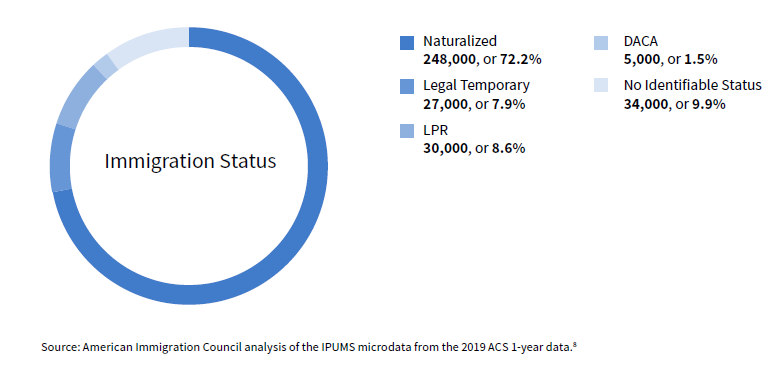
|
Immigration Status |
Number |
Share |
|---|---|---|
|
Naturalized (U.S. Citizen) |
248,000 |
72.2% |
|
Temporary (Workers, Students, etc.) |
27,000 |
7.9% |
|
Legal Permanent Resident (green card holder) |
30,000 |
8.6% |
|
Deferred Action for Childhood Arrivals (DACA) |
5,000 |
1.5% |
|
No Identifiable Status |
34,000 |
9.9% |
|
TOTAL |
344,000 |
100% |
Source: American Immigration Council analysis of the IPUMS microdata from the 2019 ACS 1-year data.
Characteristics of the Ukrainian Potential TPS Beneficiary Population
The vast majority (89.6 percent) of potential TPS beneficiaries are between the ages of 15 and 65. Almost 60 percent are between the ages of 15 and 45.
Age Breakdown Among Ukrainian Potential TPS Beneficiaries
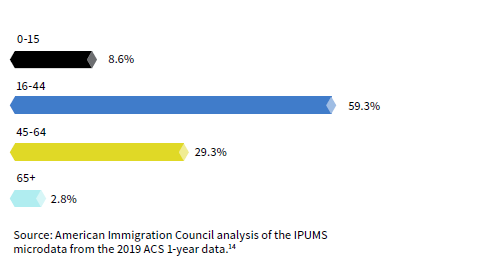
|
Age Group |
Share |
|---|---|
|
0-15 |
8.6% |
|
16-44 |
59.3% |
|
45-64 |
29.3% |
|
65+ |
2.8% |
|
TOTAL |
344,000 |
Source: American Immigration Council analysis of the IPUMS microdata from the 2019 ACS 1-year data.
There are slightly more women (56.6 percent) than men (43.4 percent) among the potentially eligible population.
Sex Breakdown Among Ukrainian Potential TPS Beneficiaries
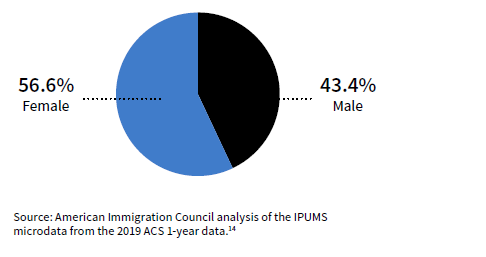
|
Sex |
Share |
|---|---|
|
Male |
43.4% |
|
Female |
56.6% |
Source: American Immigration Council analysis of the IPUMS microdata from the 2019 ACS 1-year data.
More than half (57.5 percent) of the potentially eligible population have come since 2014. More than 80 percent have been in the United States for a decade or less.
Years in the United States Among Ukrainian Potential TPS Beneficiaries
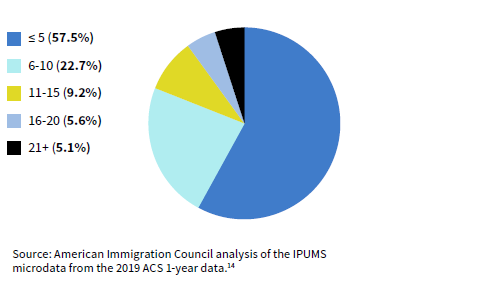
|
Years in the United States |
Share |
|---|---|
|
5 years or less |
57.5% |
|
6 – 10 years |
22.7% |
|
11 – 15 years |
9.2% |
|
16 – 20 years |
5.6% |
|
21+ years |
5.1% |
Source: American Immigration Council analysis of the IPUMS microdata from the 2019 ACS 1-year data.
There is an almost even split between those who reported speaking Ukrainian at home (47.8 percent) and those who spoke Russian at home (44.6 percent).
Language Spoken at Home Among Ukrainian Potential TPS Beneficiaries
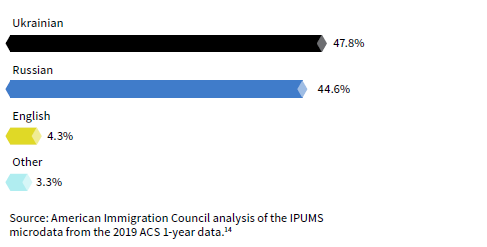
|
Language |
Share |
|---|---|
|
Ukrainian |
47.8% |
|
Russian |
44.6% |
|
English |
4.3% |
|
Other |
3.3% |
Source: American Immigration Council analysis of the IPUMS microdata from the 2019 ACS 1-year data.
About one-fifth of Ukrainian potential TPS beneficiaries live in Illinois; one-tenth live in Michigan; and less than one-tenth each live in California and New York.
Top Four States of Residence Among Ukrainian Potential TPS Beneficiaries
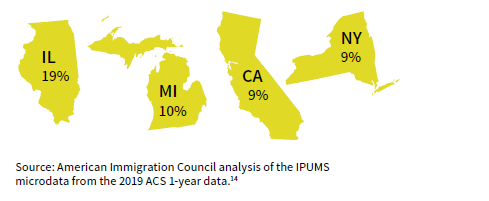
|
States |
Share |
|---|---|
|
Illinois |
19% |
|
Michigan |
10% |
|
California |
9% |
|
New York |
9% |
Source: American Immigration Council analysis of the IPUMS microdata from the 2019 ACS 1-year data.
The potentially TPS eligible population of Ukrainians is highly educated compared with the overall population of the United States. While about one-third of all foreign-born (32.7 percent) and U.S.-born Americans (33.1 percent) hold at least a bachelor’s degree, about one-half (49.6 percent) of Ukrainians who could benefit from TPS hold at least a bachelor’s degree.
Education Attainment Among Ukrainian Potential TPS Beneficiaries
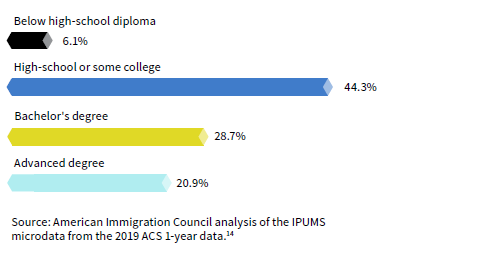
|
Educational Attainment |
Share |
|---|---|
|
Less than a high school diploma |
6.1% |
|
High school or some college |
44.3% |
|
Bachelor’s degree |
28.7% |
|
Advanced degree |
20.9% |
Source: American Immigration Council analysis of the IPUMS microdata from the 2019 ACS 1-year data.
Among those 16 years or older, about three out of four (73.5 percent) are active in the labor force, and nearly all (97.1 percent) of those who are active in the labor force are employed.
Labor Force Participation Among Ukrainian Potential TPS Beneficiaries
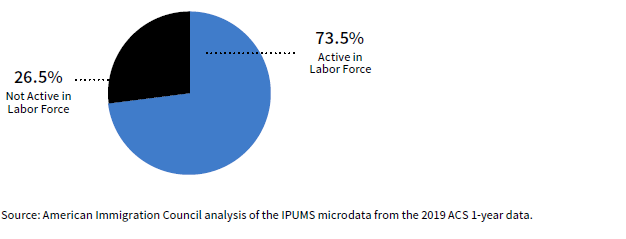
|
Labor Force Participation |
Share |
|---|---|
|
Not in labor force |
26.5% |
|
Active in labor force |
73.5% |
Source: American Immigration Council analysis of the IPUMS microdata from the 2019 ACS 1-year data.
Employment Rate Among Ukrainian Potential TPS Beneficiaries Active in the Labor Force
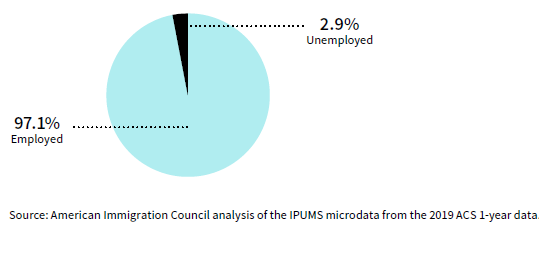
|
Employment Rate |
Share |
|---|---|
|
Employed |
97.1% |
|
Unemployed |
2.9% |
Source: American Immigration Council analysis of the IPUMS microdata from the 2019 ACS 1-year data.
Among employed potential TPS beneficiaries, the most common industry in which they were active was Healthcare and Social Assistance, which includes work in hospitals, health clinics, doctor’s offices, and childcare facilities. This was followed by the Construction and Administrative Support sectors.
Top Five Industries Among Ukrainian Potential TPS Beneficiaries in Workforce

|
Industries |
Share of Workers |
|---|---|
|
Health Care and Social Assistance |
13.2% |
|
Construction |
12.5% |
|
Administrative Support |
11.2% |
|
Tourism, Hospitality, and Recreation |
11.1% |
|
Professional, Scientific, and Technical |
10.3% |
|
Other industries |
41.7% |
Source: American Immigration Council analysis of the IPUMS microdata from the 2019 ACS 1-year data.
Methodology
These estimates were produced by leveraging microdata from the American Community Survey (ACS) downloaded from the Integrated Public Use Microdata Series (IPUMS) database. The dataset used for this analysis was the 2019 ACS 1-year data. Overall, we define an immigrant as anyone born outside the country to non-U.S. citizen parents who is a resident of the United States. This includes naturalized citizens, lawful permanent residents (LPRs, informally referred to as green card holders), temporary visa holders, refugees, asylees, and undocumented immigrants.




